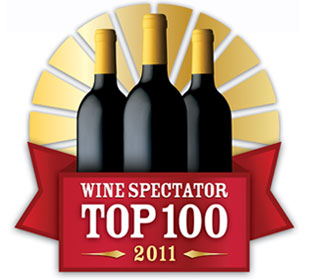Wine Spectator’s Top 100 Wines of the Year will soon be unveiled, serving to make good wines unavailable or, if they’re available, unaffordable. It’s the time of year when interesting wines dry up for the average consumer. Am I right? Isn’t this annoying? The 2012 list will wreak havoc on the wine marketplace.
 Here’s the problem with this criticism: It’s not true. And it ignores the point of The List.
Here’s the problem with this criticism: It’s not true. And it ignores the point of The List.
When it comes to Wine of the Year, savvy consumers can find most of the winners from the past decade (thanks largely to the outstanding Wine-Searcher.com). The wines from the top tens of the past decade are also easy to find.
How about affordability? You’ll often hear three main concerns:
1) The Wine of the Year becomes unaffordable
2) Future vintages of the Wine of the Year become unaffordable
3) The prices for wines in the top ten skyrocket
Let’s unpack this. First of all, the Wine of the Year does indeed see a sharp increase in price. Over the past decade, the average release price for the Wine of the Year was $67.60; the current average price is now $172.50. That’s an increase of 155%. But if we discard the past two winners, the Kosta Browne 2009 Sonoma Coast Pinot Noir and the Saxum James Berry 2007 Paso Robles, the price increase falls to 95%.

That’s a lot, but it does not make the wine off-limits. But let’s look deeper.
The price increase evaporates the next vintage. Yes, it’s a brand new wine, but it shares much in common. The average increase in price the following vintage is only 3.4% of the previous year’s release price. In other words, if you really want the Wine of the Year, you can get it for a premium. If you want its successor, you can have it without paying a premium.
How about the rest of the top ten? Turns out only the runner up wine sees much of a spike in price soon after the list comes out. The average release price for the runner-up wines was $68; today you can get those wines for an average of $100.50 per bottle, an increase of nearly 48%. The 10th-ranked wine has seen a price increase of 22%, which is not nothing, but not exorbitant in the higher-end wine market.
Now let me make a brief statement about the rapid rise in price for the Wine of the Year: Who cares? It’s one wine. There are so, so many fascinating wines in this world. More than you’ll ever be able to drink. Either you can afford to track down the winner or you can’t, but it’s not a terrible loss if this wine fades from your radar.
Instead of hunting for the Spectator Wine of the Year, you can get most of the rest of the list for a good value price. That’s a fair tradeoff. But there’s also one much better alternative yet, and it’s found on the pages of the Wellesley Wine Press.
The Coolest Parlor Game in Wine
Bob Dwyer, a Massachusetts-based wine blogger, has created the coolest parlor game in wine, and for once it’s a wine contest that does not involve blind tasting. Two years ago, Dwyer decided to find out if wine lovers could figure out the Wine Spectator Wine of the Year — before the list was released. He opened up the comments section on his blog and guesses poured in. Each year the winner gets a prize; this year the prize is a $200 Amazon gift card.
Now, I used to think the entire concept of a Top 100 list was silly. This year, mine was the first guess on Dwyer’s site. As Dwyer explains, his contest is designed to help consumers.
“The fundamental motivation for knowing the winning wine ahead of time is to provide an opportunity to buy that wine before the street price goes up,” Dwyer told me. How do you know that you can get the winning wine based on Dwyer’s contest? Well, so far, Dwyer’s contestants have sniffed out the winner in advance.
Beyond price and availability, the biggest concern with the list is that some readers think it’s supposed to represent the best 100 wines. It’s not. Some retailers think the same thing. Or at least, they sell the list that way when they make the wines available.
I used to blame Spectator for this. I’ve come to understand that this is nothing more than a problem of reader comprehension, or perhaps retailer manipulation. There is nothing wrong with the list. There is something very wrong with a retailer that tries to convince customers it’s all about the best wines in the world, all while jacking up prices.
The explanation for the Top 100 list is simple. According to the Spectator website, it’s a combination of quality, value, availability, and “x-factor.” The latter is described as “the excitement generated by a rising-star producer, a benchmark wine or a significant milestone for a wine region.” These criteria give the editors a wide range of possibilities.
“One thing that’s ironic about chasing after the winning wine is that value is baked into their equation,” Dwyer said. “It’s illogical to pay a premium for a Wine Spectator Wine of the Year. I call this ‘wrecking the QPR (quality / price ratio).”
What’s your pick?
I asked Thomas Matthews, Wine Spectator’s Executive Editor, for a little insight into how the editors carve out the list, particularly the top 10. He explained that there are now ten tasters who submit wines from their coverage regions for consideration. Then the responsibility falls on Matthews, publisher Marvin Shanken, and senior editor Bruce Sanderson to narrow that list down to about 20 wines. At that point, the ten tasters and editors convene to whittle it down.
“There’s where the discussion gets heated,” Matthews said. “We all have strong opinions and we don’t always agree. The good thing is that editors don’t only vote for their own regions. We all recognize different kinds of quality and excitement. It may take a couple of hours of discussion, and five or six votes, but we will usually come to a consensus on number one.”
Reducing wine to lists and points seems somewhat crude to me. I gravitate toward wines that express a real sense of place, and perhaps a bit of soul from the producer. Sometimes I’m smitten by wines that rack up 96 points; often I fall for wines that are maligned by the reviewers. That’s fine. My top wine might not make your list of the top 1,000, let alone 100. The best critics do a consistent job of scoring wines, but I’m concerned that the American and Asian markets in particular assume a score is the only factor that matters. The story and the work behind the wine can get lost.
But I’ve come around on this one. The Spectator list might still be too beholden to California — three out of the top ten wines on the list are, on average, from California — but it otherwise sparks great conversation. The top wine is a kind of statement not just about a single bottling but about a region. Who and where are most worthy of that recognition in 2012? Which region offers the best value? The most unheralded quality? Which wine region is the most likely to explode in the next several years? Or, perhaps, which classic wine region deserves the top spot based on a drive to deliver soaring quality at an affordable price?

“In theory, we try to rotate #1 around the wine world,” Matthews explained. “But really, we look at it like, say, the MVP award in baseball. If one player has two terrific seasons back-to-back, he’s not disqualified from winning the award twice in a row.”
If you’re interested, my guess for Wine of the Year is the Chateau de Saint Cosme 2010 Gigondas. It fits every one of the criteria. Fair price ($41), 95 points, reasonably available, and part of a vintage for the producer that Spectator now marks as the benchmark for Gigondas wines. The winemaker, Louis Barruol, is a white hot star who has had wines in the top 10 before. His Gigondas cuvees are regularly the most aromatic wines from the appellation while offering a seriously complex set of flavors.
(Full disclosure: The Spectator critic who covers Gigondas, James Molesworth, is a friend. But I have not consulted him for this guess, and even if I did, he would laugh hard enough to pull a muscle.)
I’m not afraid to divulge my guess, because Dwyer takes a wine off the board once it’s chosen for the contest. But even if Saint Cosme suffers the great injustice of not winning, the point has been made: We’re talking about a diverse group of wines. We’re talking about trends and vintages and styles. It’s fun. Dwyer gets to hand out a prize. And many of us will seek out a few wines we’ve never tasted.
Yes, there’s a lot of California, but there’s Portugal and Sancerre and Rhone and Loire and so much more in the mix. If you truly love wine, you love a good conversation about wine. Don’t stress about finding the Wine of the Year. Just use The List as another reason to think more about where wine is from, how it’s made, and what it’s telling us. The List isn’t perfect, but forget those 100-point scores — nothing in wine is perfect. It’s more interesting that way.
 Evan Dawson is the Finger Lakes Editor for the New York Cork Report and is completing a book about Finger Lakes winemakers. His paid job includes offering his best Ron Burgundy impersonation as a morning news anchor and political reporter for WHAM-TV in Rochester, NY.
Evan Dawson is the Finger Lakes Editor for the New York Cork Report and is completing a book about Finger Lakes winemakers. His paid job includes offering his best Ron Burgundy impersonation as a morning news anchor and political reporter for WHAM-TV in Rochester, NY.

